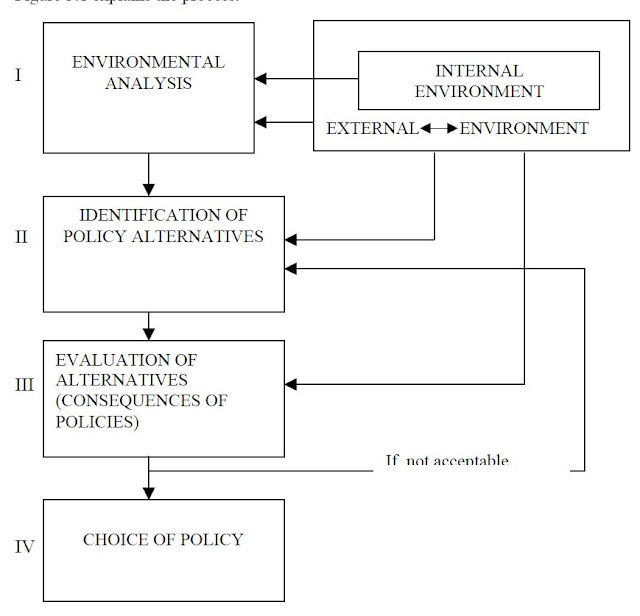A corporate policy is formulated by the top management. The formulation comprises step wise procedure. The process is similar to the decision making process and requires analysis, judgment and experience. The steps involved in the process are:
- Environmental analysis
- Identification of policy alternatives
- Evaluation of alternatives
- Choice of policy
 |
| Policy Formulation Process |
The first step in the process of policy formulation is environmental analysis. There are basically two environmental factors: internal and external. The external environment of the company comprises of economic, technological, political and social forces operating outside the boundaries of the company. These influence the company indirectly and the company has no control over them. These have to be continuously analyzed and understood before the formulation of polices.
The internal environment of the organization comprises of the firm’s employees, the organization structure, resources, value system, functional departments etc. These affect the organization’s activities directly as they are internal to the organization. Both internal and external forces interact and a change in one affects the other one. The two together provide for identification of problem areas with respect to which the policies could be made.
Once the analysis has been done, the next step requires identification of policy alternatives. The environmental analysis helps to determine the opportunities and threats facing the company and also its strengths and weakness. When the organization is engaged in the matching of its strengths with the opportunities, various policy options emerge. The options or alternatives also arise with the help of past experience, past performance results and the practices followed by the management. Identification of alternatives has to be done efficiently and then only can they be evaluated for one choice.
III) Evaluation of Policy Alternatives
 After the various alternatives have been identified, they are to be evaluated so that the best one could be
After the various alternatives have been identified, they are to be evaluated so that the best one could be IV) Choice of Policy
 The last step in the policy formulation process is the choice of the best alternative from among the various
The last step in the policy formulation process is the choice of the best alternative from among the various The various alternatives are compared with each other and the most preferred option is selected. This selected policy has to be tested so that it could be known whether it fits in the organizational boundaries and meets the organizational goals. After being successfully tested, the policy becomes ready for implementation and the manner in which it would be implemented should be explained clearly. After the policy has been made, it becomes necessary to review it from time to time so that it does not become obsolete.

Be the first to comment on "4 Stages in Formulating a Corporate Policy"